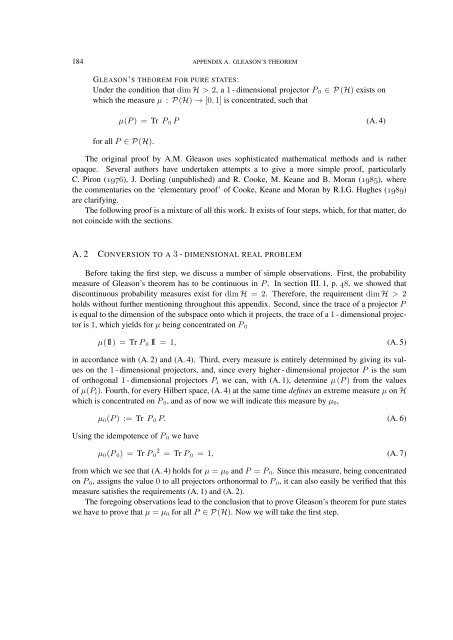FOUNDATIONS OF QUANTUM MECHANICS
FOUNDATIONS OF QUANTUM MECHANICS
FOUNDATIONS OF QUANTUM MECHANICS
You also want an ePaper? Increase the reach of your titles
YUMPU automatically turns print PDFs into web optimized ePapers that Google loves.
184 APPENDIX A. GLEASON’S THEOREM<br />
GLEASON’S THEOREM FOR PURE STATES:<br />
Under the condition that dim H > 2, a 1 - dimensional projector P 0 ∈ P (H) exists on<br />
which the measure µ : P (H) → [0, 1] is concentrated, such that<br />
µ(P ) = Tr P 0 P (A. 4)<br />
for all P ∈ P (H).<br />
The original proof by A.M. Gleason uses sophisticated mathematical methods and is rather<br />
opaque. Several authors have undertaken attempts a to give a more simple proof, particularly<br />
C. Piron (1976), J. Dorling (unpublished) and R. Cooke, M. Keane and B. Moran (1985), where<br />
the commentaries on the ‘elementary proof’ of Cooke, Keane and Moran by R.I.G. Hughes (1989)<br />
are clarifying.<br />
The following proof is a mixture of all this work. It exists of four steps, which, for that matter, do<br />
not coincide with the sections.<br />
A. 2 CONVERSION TO A 3 - DIMENSIONAL REAL PROBLEM<br />
Before taking the first step, we discuss a number of simple observations. First, the probability<br />
measure of Gleason’s theorem has to be continuous in P . In section III. 1, p. 48, we showed that<br />
discontinuous probability measures exist for dim H = 2. Therefore, the requirement dim H > 2<br />
holds without further mentioning throughout this appendix. Second, since the trace of a projector P<br />
is equal to the dimension of the subspace onto which it projects, the trace of a 1 - dimensional projector<br />
is 1, which yields for µ being concentrated on P 0<br />
µ(11) = Tr P 0 11 = 1, (A. 5)<br />
in accordance with (A. 2) and (A. 4). Third, every measure is entirely determined by giving its values<br />
on the 1 - dimensional projectors, and, since every higher - dimensional projector P is the sum<br />
of orthogonal 1 - dimensional projectors P i we can, with (A. 1), determine µ (P ) from the values<br />
of µ(P i ). Fourth, for every Hilbert space, (A. 4) at the same time defines an extreme measure µ on H<br />
which is concentrated on P 0 , and as of now we will indicate this measure by µ 0 ,<br />
µ 0 (P ) := Tr P 0 P. (A. 6)<br />
Using the idempotence of P 0 we have<br />
µ 0 (P 0 ) = Tr P 0 2 = Tr P 0 = 1, (A. 7)<br />
from which we see that (A. 4) holds for µ = µ 0 and P = P 0 . Since this measure, being concentrated<br />
on P 0 , assigns the value 0 to all projectors orthonormal to P 0 , it can also easily be verified that this<br />
measure satisfies the requirements (A. 1) and (A. 2).<br />
The foregoing observations lead to the conclusion that to prove Gleason’s theorem for pure states<br />
we have to prove that µ = µ 0 for all P ∈ P (H). Now we will take the first step.
















